“Once a landscape has been established, its origins are repressed from memory. It takes on the appearance of an "object" which has been there, outside us, from the start. An ‘object,’ however, can only be constituted within a landscape. The same may be said of the ‘subject’ or self. The philosophical standpoint which distinguishes between subject and object came into existence within what I refer to as ‘landscape.’ Rather than existing prior to landscape, subject and object emerge from within it.” In “The Discovery of Landscape,” Kojin Karatani analyzed the insights of many intellectuals, such as Paul Valéry and Sigmund Freud, on “landscape” in painting, contemplating on how “landscape” in art and literature reflects the subjectivity of its creators. In his view, “only in the case of a landscape can the creator's subjectivity be reflected in art and literature”. In his view, “It is only within the ‘inner man,’ who appears to be indifferent to his external surroundings, that landscape is discovered. It is perceived by those who do not look ‘outside.’”
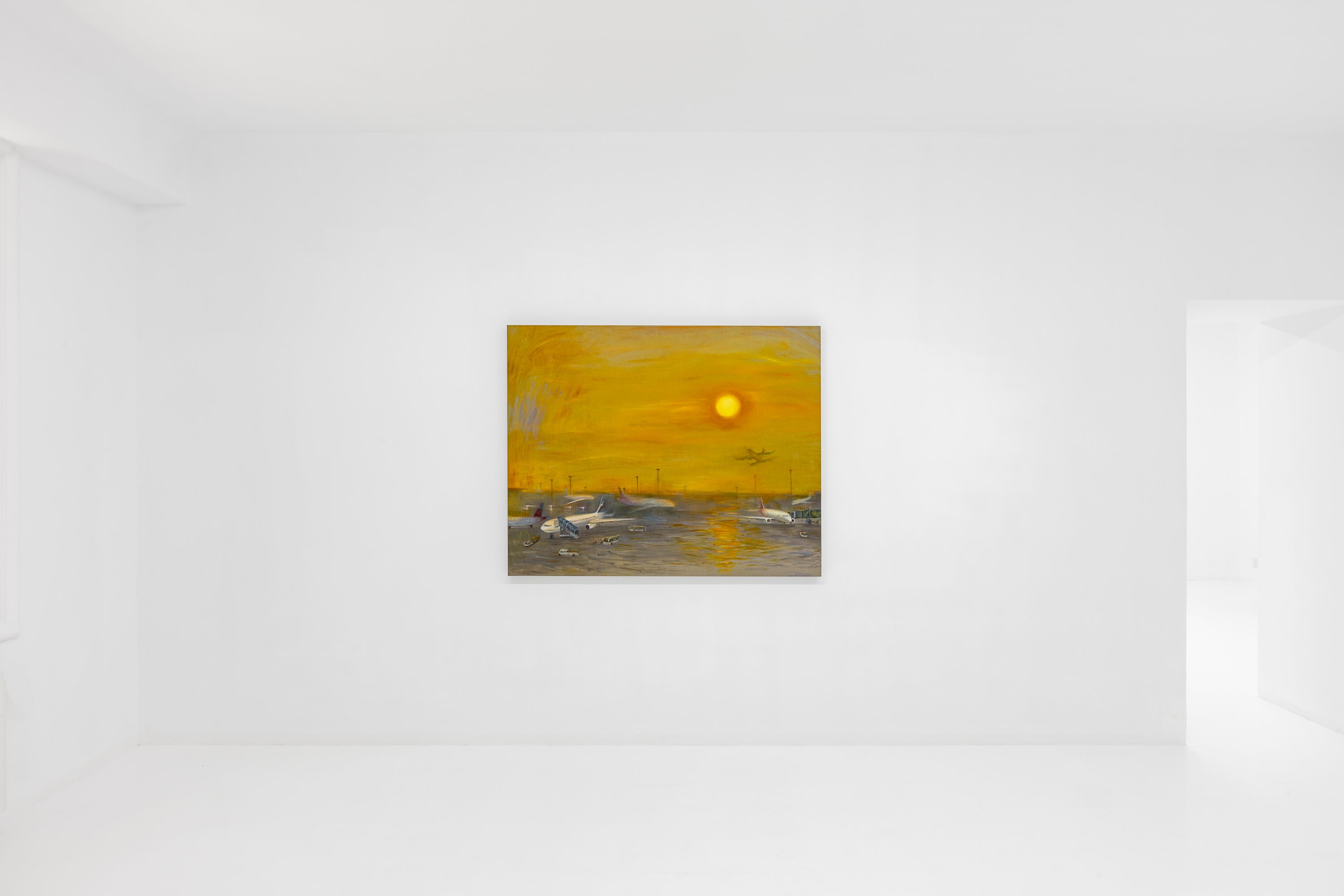
Installation View, Yan Xinyue: Revisit, Capsule Shanghai, Shanghai, China; Photographed by Ling Weizheng
Yan Xinyue's latest solo exhibition “Revisit” presents various “landscapes”. They are not mountains or rivers, but rather vignettes of mundane urban life. Compared with her earlier works, Yan’s recent paintings exemplify her shifting focus from “what to paint” to “how to paint”. This is related to her experience of constant migration. In an unfamiliar context, existing physical habits may not duly adapt to the new environment. New surroundings dominate the mind and take it on a process of transformation, often accompanied by the subsequent psychological projection. Yan Xinyue chooses unexpected scenes to host seemingly small and placid figures. Influenced by the remarkable brushwork of impressionist painters, such as Claude Monet and Edvard Munch, she paints as a way to change her mentality, and in doing so, landscape becomes a medium of emotions. Naturally for a contemporary artist, she makes paintings about her day-to-day experience. Driven by inner impulses, she breaks away from established methods to construct something new through “revisiting”.
FIONA HE
X
YAN XINYUE
X
YAN XINYUE
Fiona He (hereinafter referred to as FH): When I saw the title of the exhibition “Revisit”, I immediately thought of the coexistence of familiarity and strangeness. Perhaps “revisiting” any place we have traveled to or lived in would conjure a disorienting but at the same time fascinating feeling - an alienated sense of belonging perhaps. Is this the kind of emotions you wanted to explore in this exhibition?
Yan Xinyue (hereinafter referred to as YXY): Indeed, the exhibition starts from an emotional or lyrical perspective. Like a poem about looking back at my past experience, it is filled with waves of emotions. Lately I have been looking at a lot of German Expressionist paintings. I want to create an empathy with the viewer through emotions. In my earlier works, I tended to focus on “what to paint” without so much consideration of communicating emotions, whereas now I give a lot of thoughts to the “how” of painting. For example, how the way the brush touches the canvas can convey emotions, and what unexpected effect can come out of the wrestle between the two. Sometimes my painting is more like “writing” in calligraphy. It is a fun exploration for me. Back to your question about the theme of the show, I chose as the starting point the mixed feeling behind a “sense of belonging”. The title “revisit” is a very emotional word.
FH: You studied in Europe, and later moved to Shanghai and recently Los Angeles, during which period you must have frequently returned to Guangzhou, where you grew up. Every time you leave and return, you are “revisiting” in a sense. What specific scenarios trigger the mixed feelings of familiarity and strangeness? How do you integrate real-life scenarios into your works?
YXY: The strangeness you mentioned is more like alienation for me. I believe that there is always a group of young people in China who have lived in many places but find it difficult to settle down in one place. Whether they are living in China or abroad, they are always planning the next city to move to, or constantly drifting from one country to another. They choose the nomadic lifestyle. To a large extent, this group of young Chinese people now struggle even more to find their spiritual home due to globalization. This roving state of being is ubiquitous in my work.
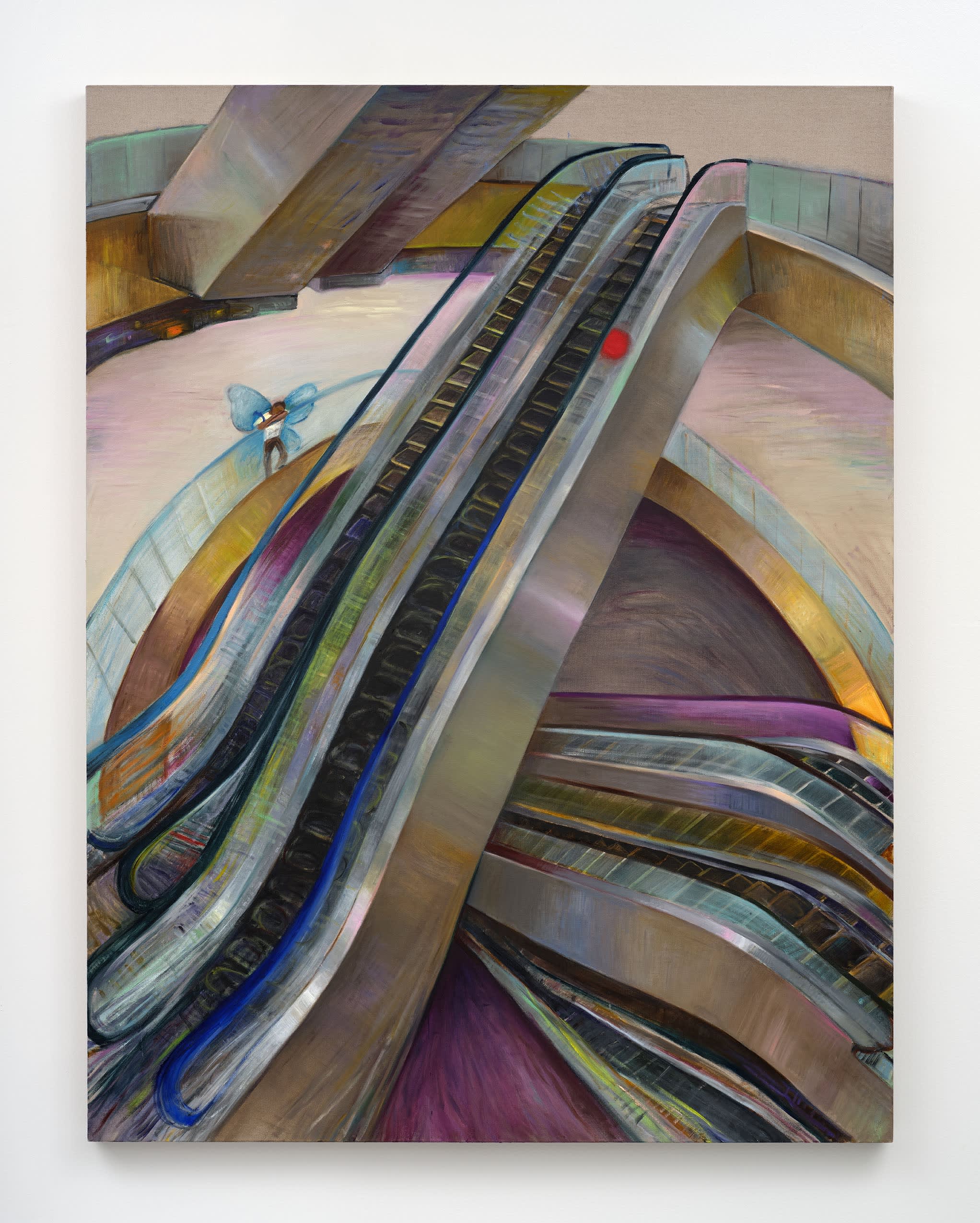
Yan Xinyue 闫欣悦 | Him and his landscape 他和他的风景 | 2024 | oil on linen 亚麻布面油画 | 165 x 126 cm
FH: A sense of alienation is conveyed in the two paintings Him and his landscape and Her with her landscape #1, each featuring a lone figure. When artists tackle the subject matter of people and city, they usually choose to portray a crowd rather than an empty space as shown in these two works. Perhaps they are more of a psychological landscape?
YXY: In the series that includes Him and his landscape and Her with her landscape #1, the images capture the contradiction or conflict between the individual and his/her surroundings. They are dialogues with the self in solitude, which is also my own state of mind in the past few years after I moved to the United States. I use the word “landscape” in the titles as a psychological projection. The protagonist’s smallness and calmness contrast with the fast and varied brushstrokes I used to paint the surrounding landscape. It is a psychologically fabricated landscape that reflects the protagonist’s loneliness and struggle, so in these works, emotions mostly take place in the landscape.
FH: Although these works are not very large in scale, the proportion between the figure and the environment enhanced the sense of emptiness. Is this a particularly effective composition for you?
YXY: It’s hardly original to paint small figures in vast and empty environments. When making the works, I thought of the composition of ancient Chinese paintings, where small figures with simple postures are placed in a grandiose background. I also thought of the ancient poems we studied in school - their lyricism and humans’ smallness and powerlessness in certain environments.
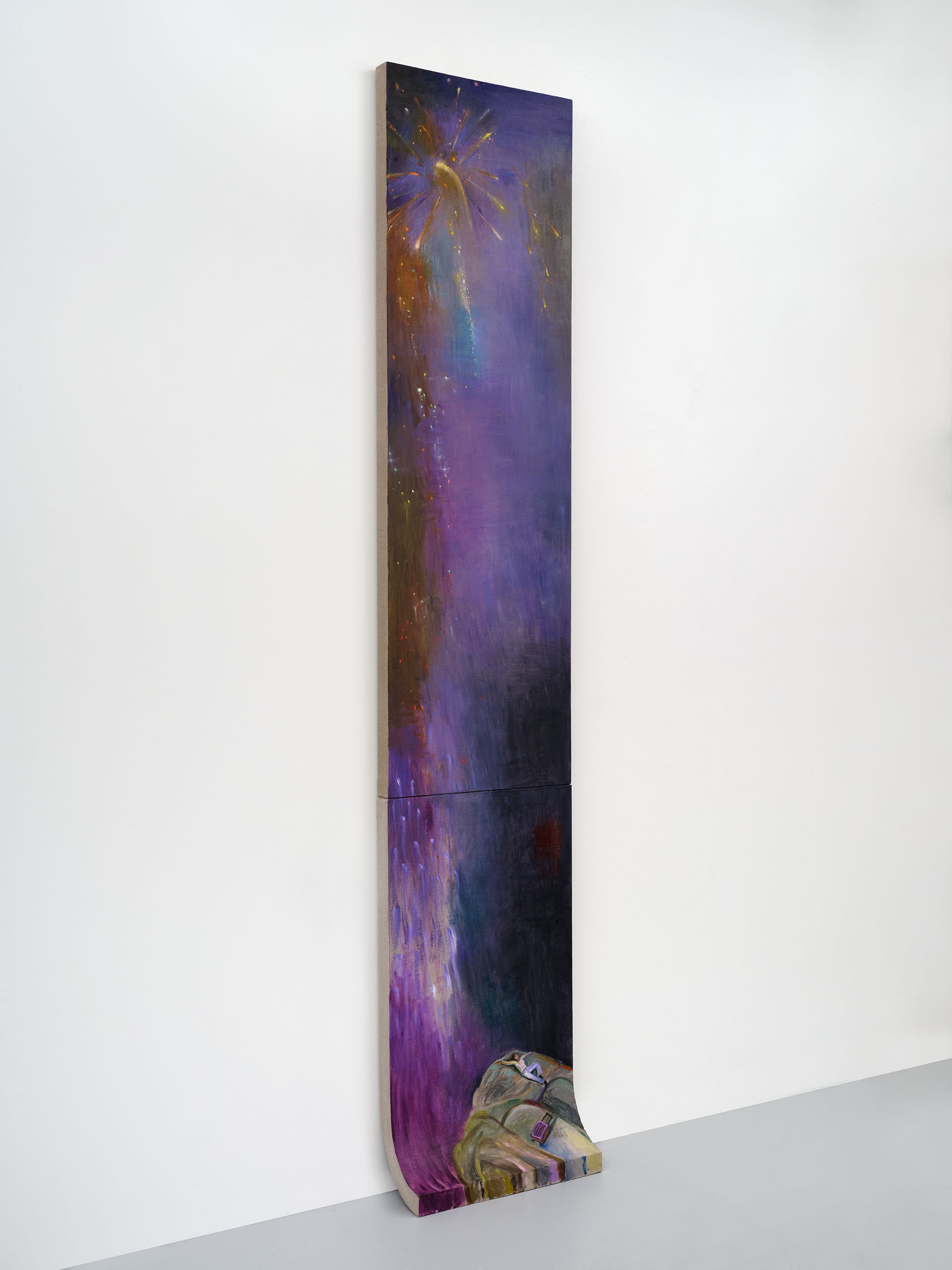
Yan Xinyue 闫欣悦 | Her with her landscape#1 她和她的风景#1 | 2024 | oil on linen 亚麻布面油画 | Two panels in 145 x 45 cm and 80 x 45 cm(双联画)
FH: Her with her landscape #1 has a special stretcher that curves at the bottom, which is almost like it is connecting the sky with the earth. What is the intention behind the form of the stretcher?
YXY: Initially my intention was to break away from the monotonous way of displaying a painting on the wall. The curved stretcher extends from the wall to the floor, like an ancient Chinese scroll painting unfolding in front of you. It invites viewers in and encourages them to spend more time looking at the painting. The upright and tall frame makes people look up. I was really impressed by Monet’s large paintings of water lilies at Musée de l'Orangerie in Paris. I marveled at how I was surrounded by and deeply immersed in his brushwork. The rapid and gestural sweeps of brushstrokes in Her with her landscape #1 are influenced by Monet to a great extent. Paint intersects and overlaps to expand into an entire dark night. It is not a rationally planned work. I released a lot of emotions into it. It has the energy of rapid brushwork.

Wang Ximeng 王希孟, A Thousand Li of Rivers and Mountains 千里江山图, 1113 北宋政和三年, Handscroll, ink and color on silk 卷轴绢本设色, 51.5 x 1191.5 cm, Palace Museum, Beijing, China 故宫博物院,中国北京

Claude Monet 克劳德·莫奈, Musée de l'Orangerie 橘园美术馆, Paris, France 法国巴黎
FH: Your recent paintings show the influence of the Impressionists. Take Awaiting as an example. How the setting sun shines on the ground at the airport reminds me of Edvard Munch’s painting The Mystery of a Summer Night. Your chosen color palette also seems to intensify the emotion of waiting.
YXY: Awaiting is influenced by Monet's painting Impression, Sunrise. In John Berg’s writing about Monet's work, he mentioned that Impression, Sunrise is charged with melancholy and a sense of homelessness. As I look at this piece for a long time, I started to see an airport. Fluid light melts into the floating ground. The passenger finally gets on the plane after a long day, looking forward to get some shuteye while being transported to the destination. Munch's landscape paintings have also influenced my works in the exhibition. His bravery and freedom are something I crave.
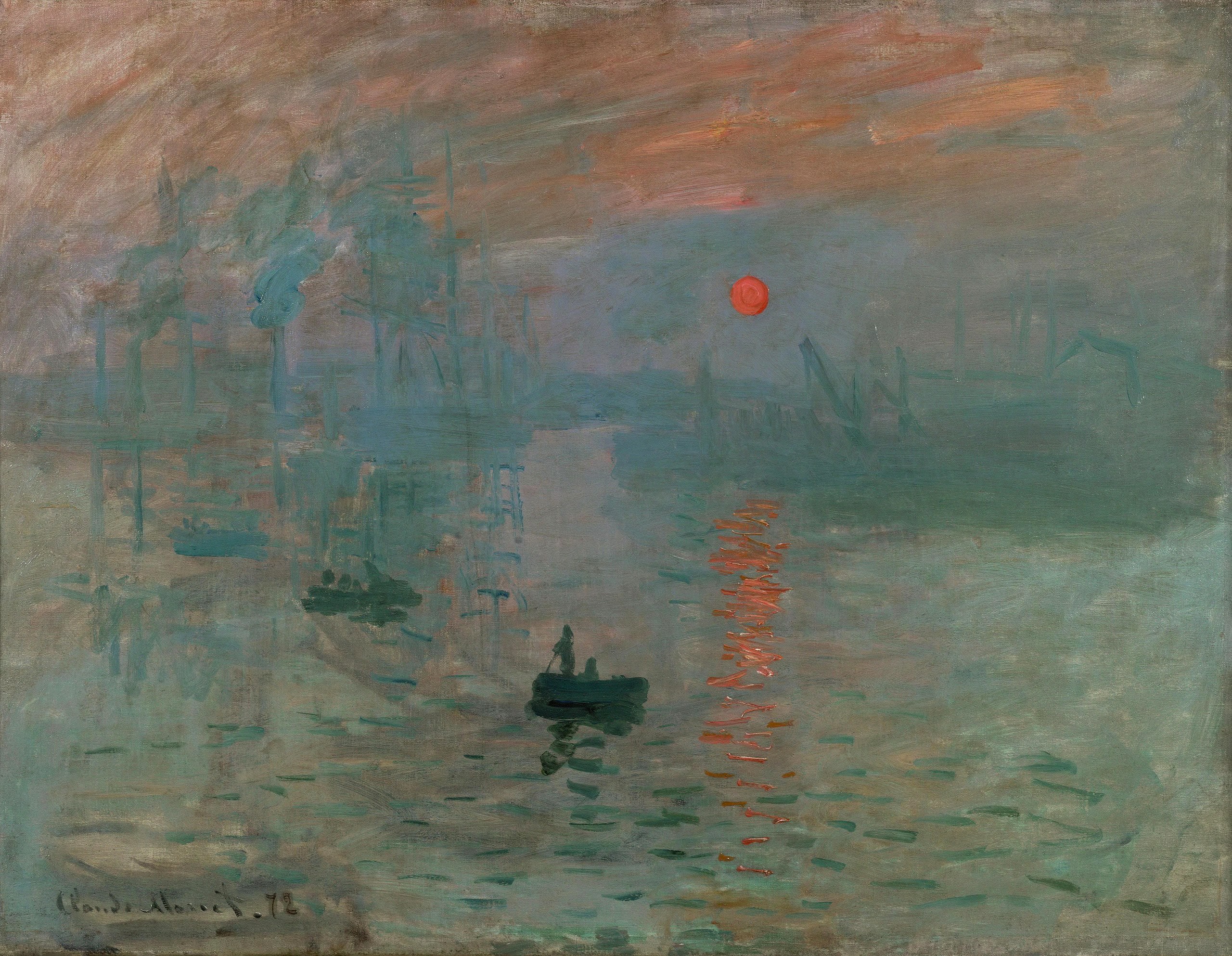
Claude Monet 克劳德·莫奈, Impression, Sunrise 印象·日出, 1872, oil on canvas 布面油画, 48 x 63 cm, Musée Marmottan Monet 玛摩丹美术馆, Paris, France 法国巴黎

Edvard Munch 爱德华·蒙克, Beach 沙滩, 1904, oil on canvas 布面油画, 81 x 109.5 cm, Munch Museum 蒙克美术馆, Oslo, Norway 挪威奥斯陆
FH: There is a lot of untreated linen canvas in the works on view. The blank space makes more prominent the relationship between color and canvas.
YXY: Unprimed linen canvas reduces color purity, and somehow alleviates the conflict among different colors. Perhaps it also creates a rawness, which is quite fitting in this exhibition. I often leave the linen blank, or paint some translucent brush strokes to transition between the painted and blank surfaces, so that the thin layer of color contrasts with linen’s rough texture. It challenges the notion of whether a painting is done. There is a saying about the process of painting: “Every stroke can be an opportunity. Every stroke can also be destruction”. For me, the perfect combination of the linen, translucency of color, and resolute brushwork is very precious. I try to sharpen my perception to find this perfect combination.
FH: In addition to blank space, I also find it interesting that in Peaceful Afternoon & Hirugao: Love Affairs in the Afternoon, you adopted a nested way of looking. The work features the scene of someone watching the TV, suggesting the presence of a viewer. At the same time, the Japanese drama Hirugao: Love Affairs in the Afternoon is a metaphor of an escape from reality. In this way you amplify feelings on both internal and external levels. Is this an approach you might continue to try in future works?
YXY: I like the word “nested”. For me this logic implies a “picture within a picture”. I had actually made a couple of works with similar perspectives, and will continue to experiment with it. It allows me to paint in different ways within a single frame. In some parts I inserted images from reality. This image must be recognizable in order to add meaning to the work, and therefore has to be painted realistically. The rest of the painting can be experimented without so much of a plan. By using contradicting painting energies and multi-layers of viewpoint, I want people to look at my paintings for a longer period of time. Back to this painting, the orange color of the sunset in the TV show flows into real life. Imaginary and real beauty blend together, but I deliberately pulled back my perspective to that of a bystander through the popcorn and the half-eaten fruit, putting an end to the romantic atmosphere. This contraction of emotions is something I often do in my works.

Yan Xinyue 闫欣悦 | Peaceful Afternoon & Hirugao: Love Affairs in the Afternoon 悠闲的下午和”昼颜” | 2024 | oil on linen 亚麻布面油画 | 48 x 61 cm; 51 x 65 cm (framed 带框)
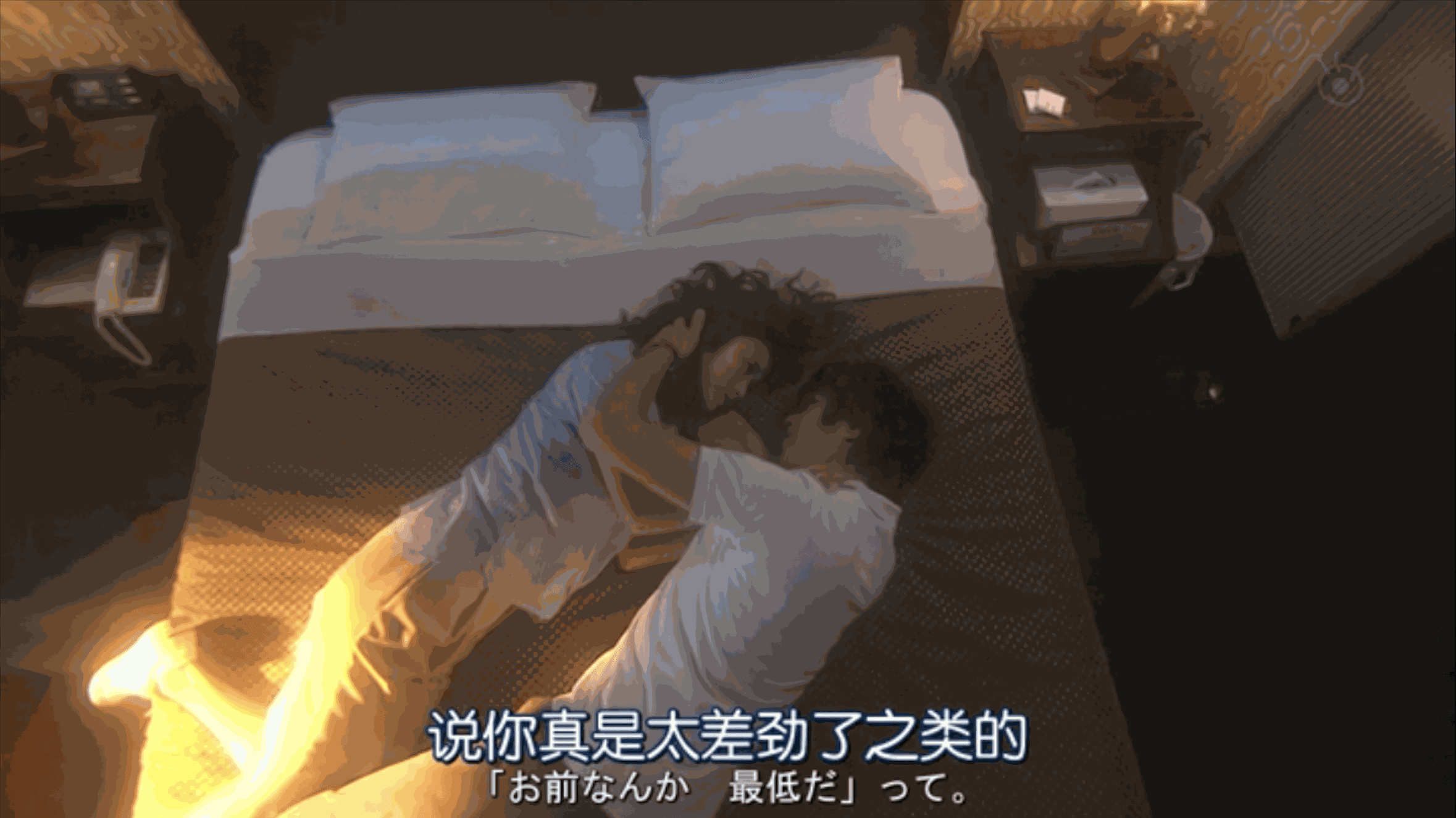
Film Still 剧照, Hirugao: Love Affairs in the Afternoon 昼颜, 2017, Directed by Hiroshi Nishitani 由西谷弘执导
FH: Although the crowd has never been your subject matter, your paintings portray a variety of animals - greyhounds, black dogs, parrots and so on. Do animals play a psychological role here?
YXY: My work often deals with the conflict between the individual and the society from a private and isolated point of view, so it is true that there is hardly any crowd in my works. I find animals very pleasant to paint. Lately I enjoy looking at Bada Shanren’s paintings. I admire his vivid and dynamic capture of animals, and try to imitate the decisiveness and uninterrupted flow of his brushstrokes. Birds in the cage reveals such painterly elements. Smearing a broad brushstroke gives form to the body of a bird. Maybe it’s meaningless; maybe it’s an intentional portrayal. I paint the same things in different ways, which is very enjoyable. Sometimes when I finish painting something but still want to paint more, I try to find a new way to paint the same subject. Unexpected humor may come out of this process. It makes me chuckle.
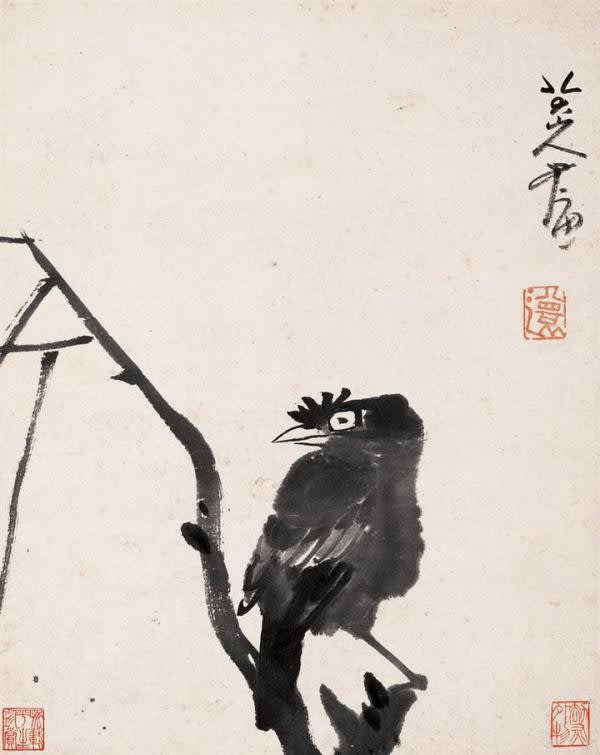
Bada Shanren (Zhu Da) 八大山人(朱耷), Bird 鸟, 1627 - 1705
FH: Artists often paint self-portraits in a metaphorical way, searching for a new direction through introspection. Do you think any of the works in this exhibition can be considered a self-portrait?
YXY: There is in fact a self-portrait in the exhibition. Painters in history used to made self-portraits at different stages of life, so I followed that tradition. I had always been scared of painting me, and was surprised to get this impulse this time. I struggled for a long time while making the painting. I studied the works of many masters, and even went through catalogues of Goya’s work several times. My struggle during that period of time made its way into this self-portrait. (The background was repainted several times.) It can also be seen as a sketch painted from life.
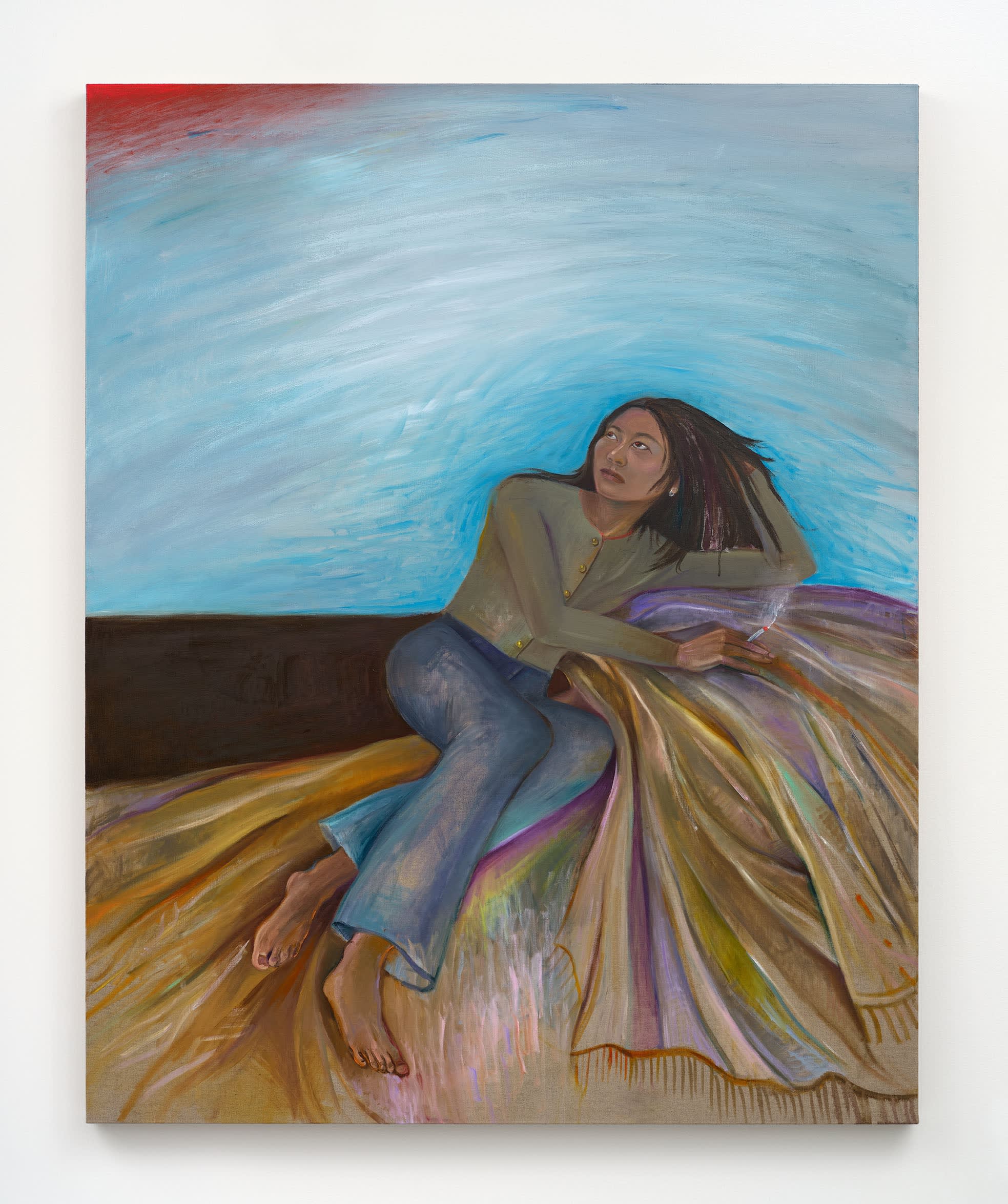
Yan Xinyue 闫欣悦 | Gaze 凝视 | 2024 | oil on linen 亚麻布面油画 | 150 x 120 cm
FH: You seem to have intentionally chosen colors that are contemporary and even trendy - the Tiffany blue in Untitled, the baby pink of the greyhound, and the fashionably colorful parrot feathers.
YXY: True. I am very conscious about how one color relates to another. I like to look for collision and stimulation among colors. Sometimes I would start with simple color blocks from my sketchbook, and step by step develop them into a concrete narrative. A powerful block of color can be more striking than an elaborate image. In my recent works, I tend to trust my intuition of colors and let it speak the language of painting itself.
FH: I've also noticed that Self care #3 is a diptych contained in one frame. The physical fracture is quite intriguing because you could have just painted on a longer piece of canvas. The protagonist is surfing the Internet while in reality getting a facial alone. The seam down the middle implies the shatter she may be experiencing in life. The horizontal format is also reminiscent of Chinese scroll painting.
YXY: Yes. This painting has an abundance of blank space. It barely conveys any emotions. The bizarre light therapy facial mask and the quiet puppy constitute a timescape of leisure, but because the work is a collage of two stretchers, the gap down the middle accidentally creates a sense of loneliness and incompleteness, which is quite interesting now that I think about it.
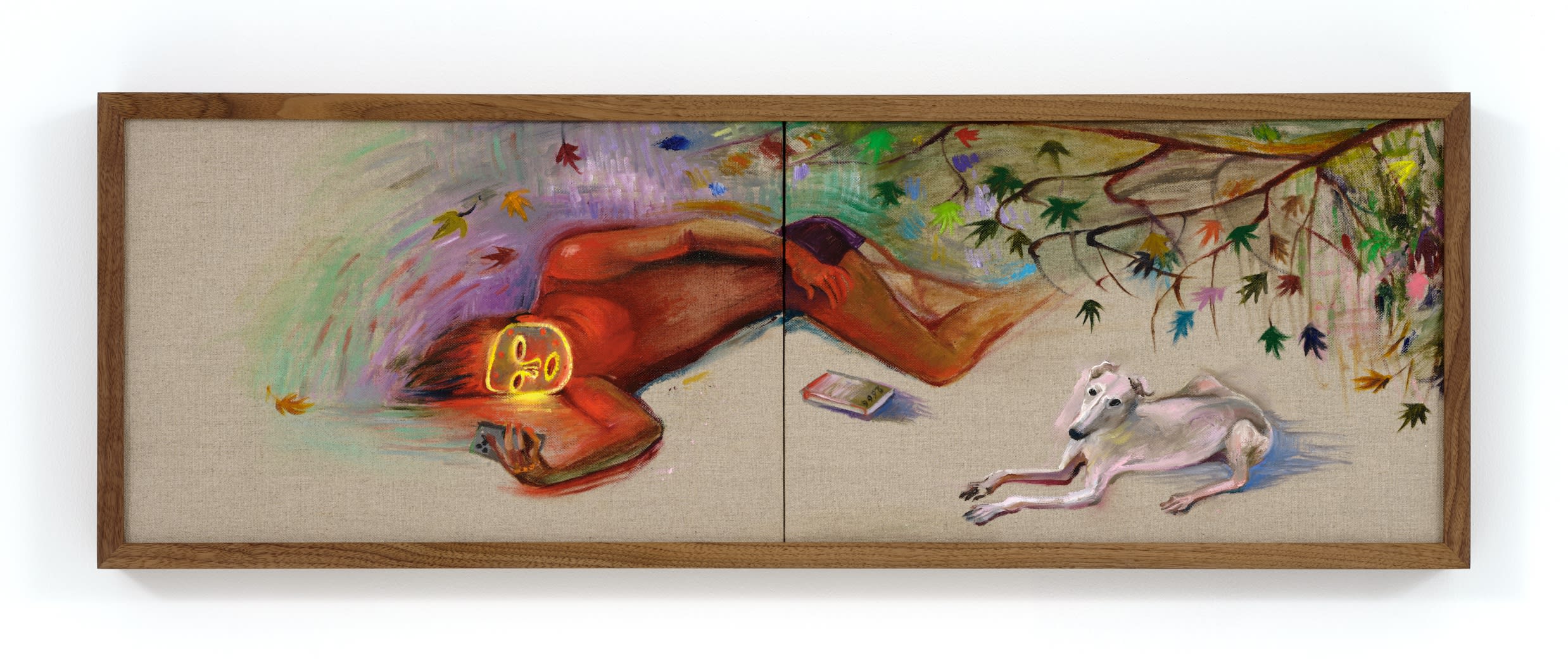
Yan Xinyue 闫欣悦 | Self care #3 自爱时光#3 | 2024 | oil on linen 亚麻布面油画 | 27 x 81.5 cm; 29 x 83 cm (framed 带框)
FH: Do you feel more conscious about your cultural background after moving to L.A.? Have you gained a new understanding of fluid identity and the ever-changing sense of belonging?
YXY: Back when I was studying in the Europe, I used to be troubled by the question of how my work relates to my cultural background. Not any more though. Now I allow the work to evolve naturally and spontaneously. This way I have more freedom to explore painting itself. I think as long as we continue to have dialogues with the self, we don't need to define our cultural background because everything about ourselves – culture or experience – will have naturally been channeled into the works. In terms of culture, I’m more interested in exploring the roving through different identities and cultural contexts, the obstacles we run into along the way, and the all-encompassing perspective and wisdom we gain in the end. I don’t intend to force myself into new cultural contexts, or conform to old ones. I try to be self-consistent and make honest choices based on considerations to myself. For this exhibition, I painted a scene from the Japanese drama that I like, and a portrait of a Chinese singer whom I deeply admired, Coco Lee, who passed away last year. These mundane vignettes touch me in a very real way. I think this is a way for me to express my cultural experience and sense of belonging.
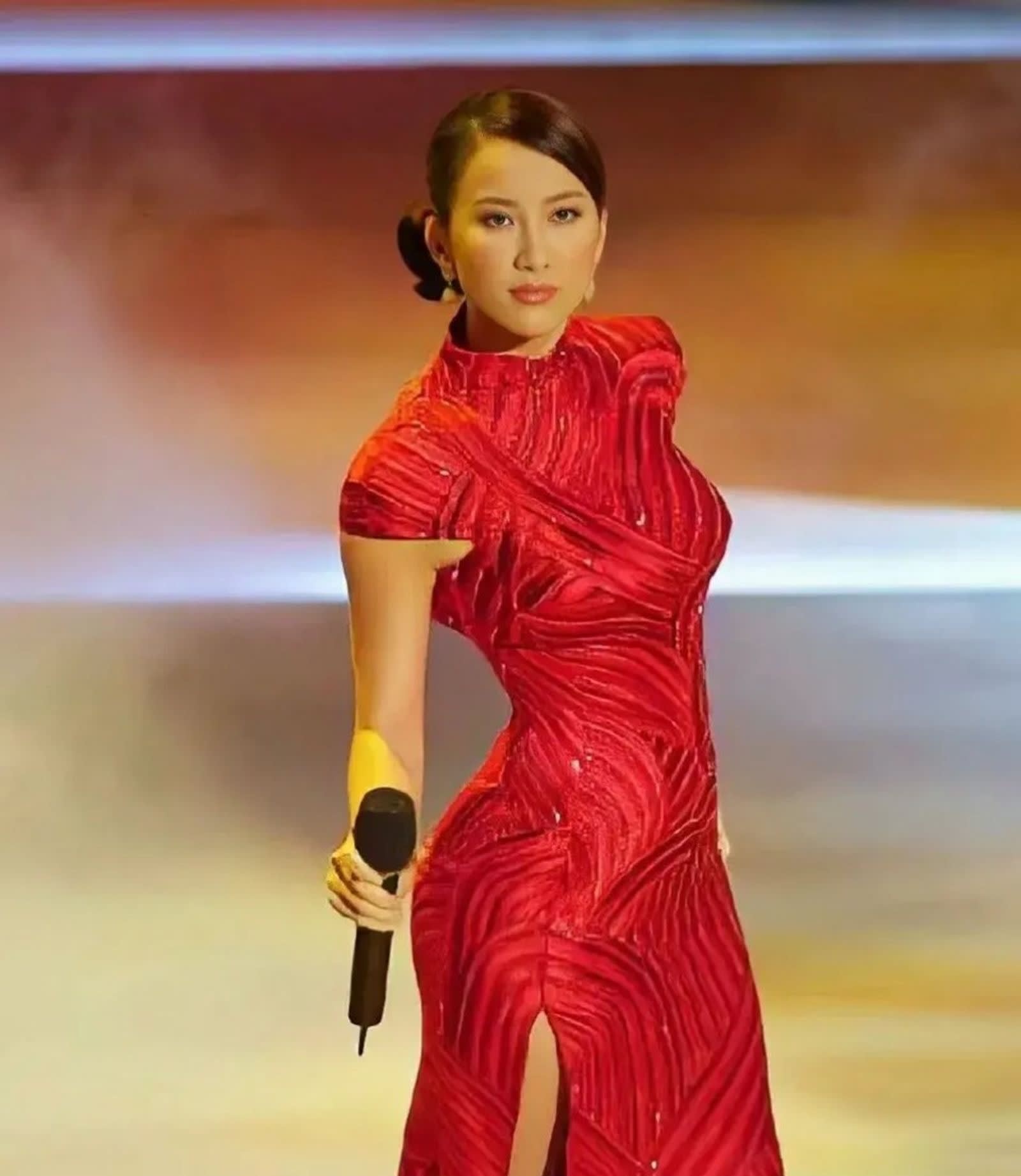
Coco Lee performing at the Academy Awards ceremony for Ang Lee's film Crouching Tiger, Hidden Dragon, 2001
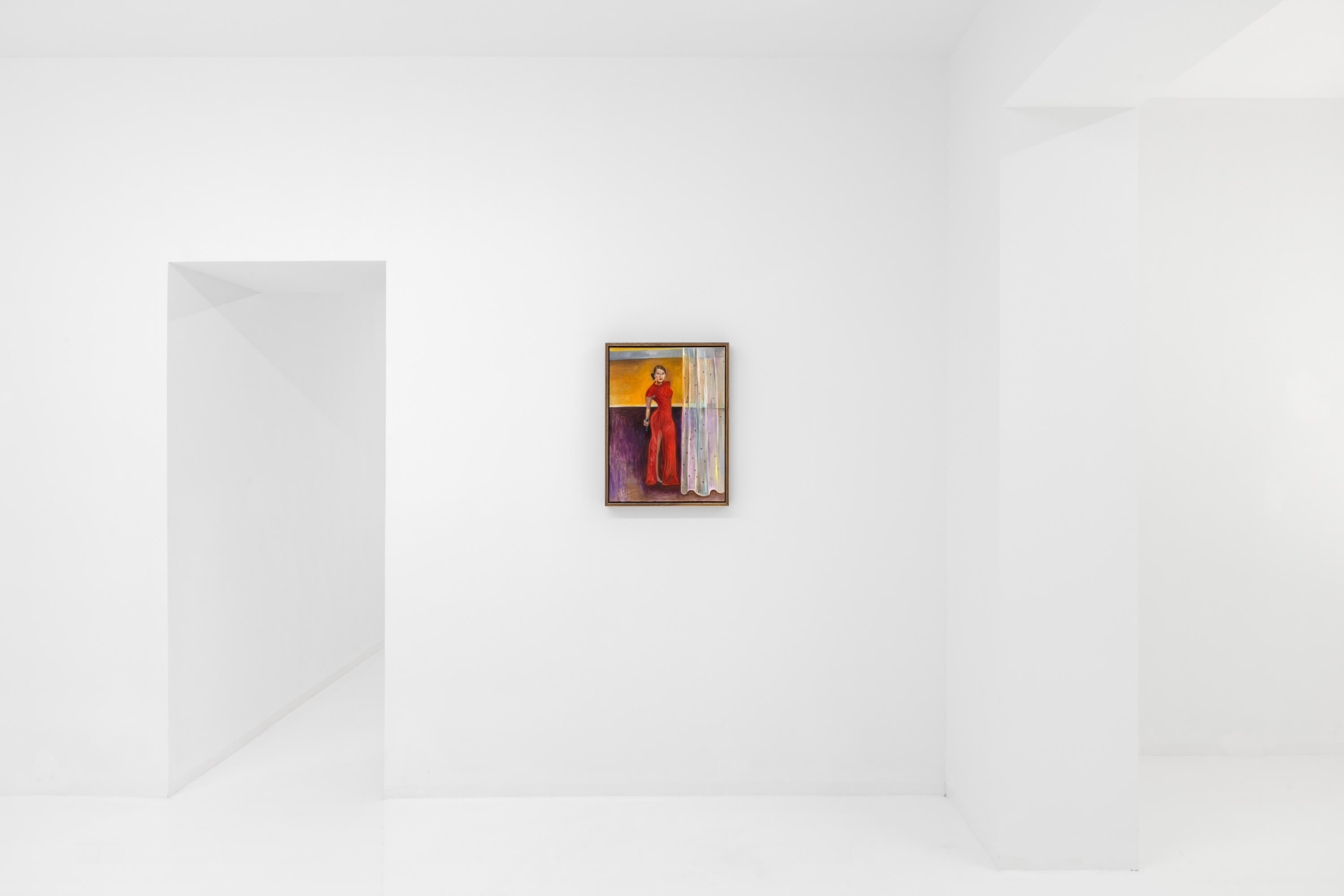
Installation View, Yan Xinyue: Revisit, Capsule Shanghai, Shanghai, China; Photographed by Ling Weizheng



